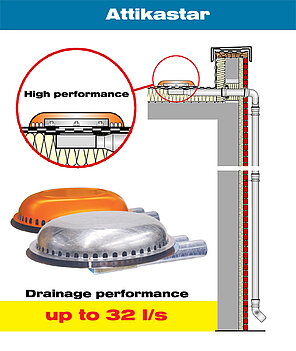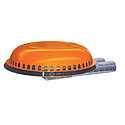Series 93 LORO-X Attikastar high performance
Series 93: LORO ATTIKASTAR®
with a strong performance below the cover

LORO-X Attikastar® parapet drainage systems are equipped with a large cover circumference for a strong discharge rate. With help of the patented double-pipe-principle and due to the silent-power siphonic flow, they reach a discharge rate of 32 l/s at a water height of only 55 mm in the case of smooth operation.
The penetration into the thermal insulation of the roof is minimized by the LORO-X double-pipe-principle. With help of the Y-piece behind the parapet two DN 70 pipes are joined to one DN 100 pipe. This is why the suction effect starts reliably and already with a small amount of water.
The weir beneath the cover can be modularly adapted to the circumstances of the building by choosing a height between 25 mm and 60 mm. Thanks to the large cover of the Attikastar, noise and vibration are minimized due to the construction. Hence, the Attikastar can also be used as insatiable water swallower for application cases with special noise protection requirements.
Due to its large circumference the Attikastar high-performance spout for the emergency drainage (LX 760) without downpipe guarantees a discharge rate of up to 7 l/s at a water height of only 15 mm above the weir (in the case of a 60 mm weir this equals an absolute water height of 75 mm).
Advantages:
- Power siphonic flow with a discharge rate of up to 32 l/s at a height of 55mm/75mm
- especially smooth operation due to large cover
- modular weir height from 25 mm to 60 mm
- small penetration into the thermal insulation due to patented double pipe
- fast “starting” of the siphonic flow drainage due to Y-piece
- secure sealing with round LORO-X connection pipes
Application example Series 93
Parapet drainage with siphonic flow up to 32 l/s
Flat roof >> The usage of drainage systems with suction effect across the parapet is new. Pressure resistant and backflow-proof discharge pipes are installed in front of the façade – we will describe the advantages.
In this case the secure proof of performance is as important as it is for the inside drainage with siphonic flow. Planners and installers have to be able to rely on complete system solutions with system shape and system power guaranteed by the producer.
That is why it is obvious that the complete system – including drains, fittings, pipes and outlets - should come from one provider.
The advantages are obvious:
- no openings into the building and therefore no fire protection problems
- free usage of the inside rooms as there are no pipes inside the building
- no noise problems in the building
- fewer downpipes and drains thanks to the powerful siphonic flow
- low installation costs thanks to a fast installation with push-fit sockets
- planning safety due to specification sheets with measured discharge curve and CAD-drawings
Only few drainage points
Parapet means roof edge upstand as wall-like structure at the roof edge of a building together with the roof edge closure instead of a roof gutter. As already known from the round gutter drainage, the parapet siphonic flow system is also an outside drainage. For that purpose, the roof construction is designed with an incline towards the parapet or renovated through an incline insulation towards the parapet. That way the parapet drains receive enough water.
The small number of necessary drains or low points is especially advantageous in this context. The reason for the small number of drains is the high discharge rate of the single roof drainage systems. For example, LORO’s parapet siphonic flow systems realize a discharge rate of 32 liter per second with one drain. It can substitute up to ten conventional, 500-millimeter-wide parapet openings or up to ten customary parapet-single-drains with gravity flow as main and emergency drainage system.
One has to differentiate between main and emergency drainage:
• The task of the main drainage is – in the case of normal rain – to transport the water safely from the roof through the roof drainage system into the sewer. A rain standpipe with cleaning opening at the end of the downpipe forms the interface to the ground pipe connection.
• The task of the emergency drainage is - in the case of heavy rain – to transport the water into the open, not into the sewer. A discharge into the open means transporting the water to free floodable areas around the building or to especially installed retention devices for rainwater. For that purpose, an emergency drainage system with drain and downpipe for a controlled discharge of the rainwater is strongly recommended. Conventional solutions as spout without downpipe or simple openings in the parapet as emergency drains do not meet the requirements of modern buildings.
In order to prevent the rainwater from permanently running into the open in the case of normal rain, the emergency drainage may only start draining at a defined water height on the roof. To avoid the time-consuming task of having to install the emergency drain higher, LORO’s emergency drains have a weir below the suction cover. Hence, the emergency drain can be inserted and sealed at the same level as the main drain. The control of the suction power of the water-air-mixture is used particularly advantageously here. The weir as congestion element below the suction cover is of crucial importance. Normally, the water is congested at the weir of the emergency system. In the event of heavy rain, a controlled suction power starts in the siphonic flow system. That way the water can be drained fast from the roof and is transported into the open in the case of emergency.
Control of the suction power
The widespread term siphonic flow can be easily misunderstood because often it is understood in the sense of a pressing water column. However, correctly it is a hanging water-air-mixture-column hanging from the roof drain. Here the connected pipe system pulls or sucks due to the underpressure formation. The control of the suction power is ensured by the form of the complete system consisting of drains, pipes and fittings.
This means, the strength of the suction power differs depending on the form of the complete system. Essential for the suction effect is that the water-air-mixture in the downpipe pulls the water-air-mixture in the drain downwards with help of the underpressure. Depending on the system shape, the suction effect between the lower and the upper water-air-mixture can be small (gravity flow) or strong (siphonic flow).
Identical to the function of a vacuum cleaner, the suction power is mainly controlled through the ventilation of the system. The ventilation opening of a vacuum cleaner can be opened and closed to change the suction power. The equivalent for this roof drainage system are the ventilation openings at the drain and the downpipe. The shape and size of all ventilation openings has to be optimally calculated to guarantee a safe gravity flow or a safe siphonic flow.
However, the general rule is that especially for siphonic flow a pressure-resistant and backflow-proof pipe system has to be used. Steel discharge pipes have proven effective for all types of roof drainage. Due to the weir below the cover, these roof drainage systems already reach full performance at an absolute water height of 75 mm.
Safety guaranteed by proof of performance
The safety of a parapet roof drainage system consists in securely keeping defined threshold values. In order to guarantee this, the form and the consequential performance is essential. The system shape is defined as CAD-drawing and installed respectively on site. To each of these systems belongs a specification sheet with discharge curve. In this curve the water height on the roof (in millimeter) and the discharge rate of the system (in liter per second) are contrasted. Thus, it is calculable which defined discharge rate is provided at which water height. The essential threshold values are the maximum water height of 35 mm for the main drainage with gravity flow and 55 mm for the main drainage with siphonic flow. According to the company standard, the absolute maximum water height for the emergency drainage is 75 mm. Due to the weir below the cover, these roof drainage systems already reach full performance at an absolute water height of 75 mm.
Conclusion: Using advantages
Parapet roof drainage systems – as gravity or siphonic drainage flow – keep threshold values. Following only a few steps, the roofer can design the planning of the drainage on his own. <<




